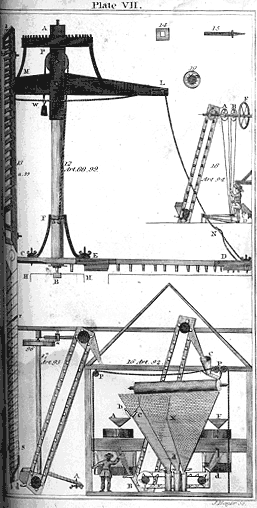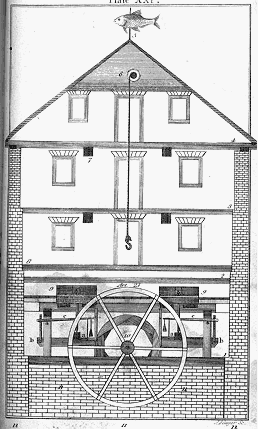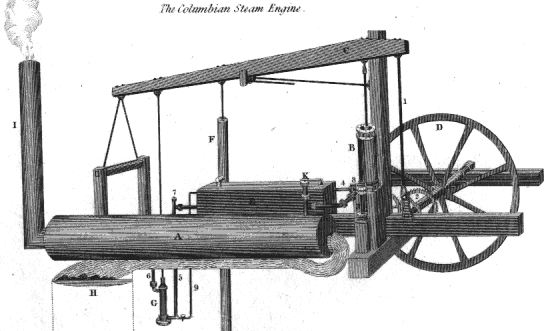Oliver Evans
Today, we meet an American original. The University of Houston's College of Engineering presents this series about the machines that make our civilization run, and the people whose ingenuity created them.
Oliver Evans was one of a kind. He was born in Delaware in 1755. That was the same year the first steam engine was started up in the Colonies -- in New Jersey, not far north of him.
Evans worked as a wagonmaker during his teens, and he studied math and science on the side. His creative ability was soon apparent. When he was 22, he was hired to produce cards for combing wool. Making the teeth for a card was slow and repetitive. Evans quickly tired of that and designed a machine to produce card teeth. Meant to turn out 500 a minute, it actually produced 1500; and they were clearly better than the hand-made ones.
Evans went on building, building. He called himself a millwright, but his mind was taking him where no millwright had gone before. He was drawn to the new source of power, steam. When he was 31 he petitioned to gain the exclusive rights to a steam-powered wagon. They called him insane for his trouble, so he set about to vindicate himself by building his own steam engine.
Evans's engine violated all the conventions of the great English engineers. They built big low-pressure engines; his engine was a small high-pressure machine. They improved efficiency by condensing the steam. He simply discarded the spent steam, and, without a condenser, his engine could fit into a vehicle.
By 1804, he did indeed produce a steam-powered wagon -- actually more than that: he produced a steam-powered amphibian -- half steamboat and half automobile. But it was his so-called Columbian high-pressure engine that fed the coming-to-life of American industry. It was our first bold step in competing with the megalithic power-based English industry.
Evans's life was fraught with soul-chewing combat over patent rights and other business dealings. He had, for example, published a very popular handbook titled The Young Mill-Wright and Miller's Guide that went through 15 reprintings. In 1805 he published a second book -- this one on steam engines. Short of money, he rushed it into print. He saw the book wasn't coming out to his own satisfaction, and -- at the last minute -- he angrily added two words to its title. The book comes down to us as: The Abortion of the Young Steam Engineer's Guide.
Evans brooded over his patent and financial troubles. In the Abortion we read the words,
He that studies and writes on the improvements of the arts & sciences labours to benefit generations yet unborn, For it is improbable that his Contemporaries will pay any attention to him.
In fact, Evans was well-to-do when he died in 1819.
That old engine, erected the year Evans was born, was now an historical monument. And, for now, Evans' engines were powering America.
I'm John Lienhard, at the University of Houston, where we're interested in the way inventive minds work.
(Theme music)
Pursell, C.W., Jr., Early Stationary Steam Engines in America. Washington, D.C.: Smithsonian Institution Press, 1969, Chapter 4.
Bathe, G. and Bathe, D., Oliver Evans. New York: Arno Press, 1972.
The very first program I did, Episode 1, was an ongoing benchmark for me. And so I redid it twice, once as a simple revison (Episode 264) and once as an elaboration of Oliver Evans's story (this Episode 285).
The story of America's first steam engine is told in Episode 28 (which I also revised later into Episode 1085.)



Various mill designs by Oliver Evans from an 1834 edition of his
Young Mill-Wright and Miller's Guide
(Images courtesy of Special Collections, UH Library)

Oliver Evans's High-Pressure Columbian Engine
(From the 1832 Edinburgh Encyclopaedia)